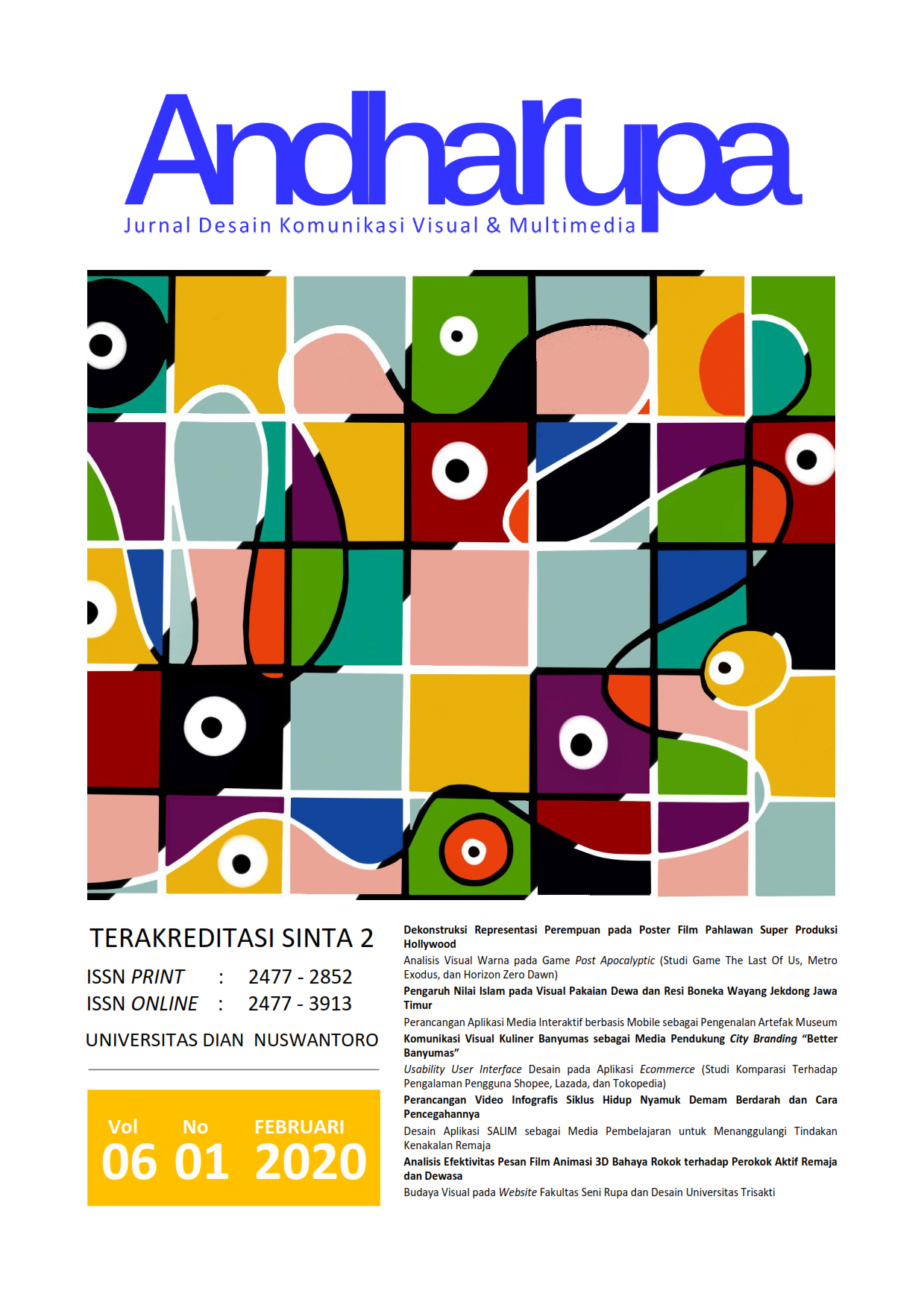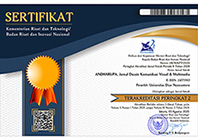Budaya Visual pada Website Fakultas Seni Rupa dan Desain Universitas Trisakti
DOI:
https://doi.org/10.33633/andharupa.v6i1.3276Abstract
Abstrak Keberadaan website Fakultas Seni Rupa dan Desain, Universitas Trisakti, penting untuk diteliti karena merupakan cermin dari budaya visual institusi yang menampilkannya. Website dapat diakses dengan berbagai perangkat pendukung seperti komputer, laptop, tablet, dan smartphone, baik kondisi pengguna (users) dalam kondisi statik maupun bergerak, serta dalam waktu yang tidak terbatas jam kerja. Metode penelitian tulisan ini adalah deskriptif-kualitatif dengan menggunakan kajian budaya. Kajian budaya dalam tulisan ini mengkaji situs website di institusi Fakutas Seni Rupa dan Desain, Universitas Trisakti dan memberikan gambaran bentuk-bentuk pengetahuan dan perilaku yang diasosiasikan dengan aktifitas sosial atau situs sosial di institusi tersebut. Hasil dari penelitian ini adalah gambaran ide, visi misi, perilaku, serta cita-cita yang hendak dibangun oleh website Fakultas Seni Rupa dan Desain, Universitas Trisakti, yang dapat membangun citra positif bagi masyarakat luas.Kata Kunci: budaya visual, desain, identitas, website AbstractThe existence of the Faculty of Art and Design, Trisakti University, website essential to research because it is a reflection of the institution's visual culture that features it. The website accessible through various devices, such as a computer, a laptop, tablet, smartphone when users at static or mobile state, and within unlimited working hours. This research using descriptive - qualitative with the cultural study approach. The cultural study on this research analyzes the Faculty of Art and Design, Trisakti University, website and providing the picture of knowledge forms and attitudes which associate with social activity and social site in the institution. The result of this research is idea picture, vision, mission, attitude, and the goal that wishes to build by the Faculty of Art and Design, Trisakti University website that can develop a positive image to the larger society.Keywords: design, identity, culture, visual, websiteReferences
De Certeau, M. 1984. The Practice of Everyday Life. University of California Press, Berkeley, Los Angeles.
Dufrenne, M. 1979. Main Trends in Aesthetics and the Sciences of Art. Holmes and Meier Publisher Inc. New York
Hall, S. Jessica, E. 1999. Visual Culture: The Reader. Thousand Oaks. SAGE Publications, Open University. London.
Mahsun. 2007. Metode Penelitian Bahasa. Jakarta. PT. Raja Grafindo Persada.
McLuhan, M., Quentin F.. 2005. The Medium is the Message: an Inventory of Effects. Mass Market Paperback, GB.
Mirzoeff, N. 2009. An Introduction to Visual Culture (2nd edition), New York, Routledge.
Sachari, A. 2007. Budaya Visual Indonesia: Membaca Makna Perkembangan Gaya Visual Karya Desain di Indonesia abad ke-20. Penerbit Erlangga, Jakarta.
Survey Penetrasi dan Perilaku Pengguna Internet Indonesia. 2017. Infografis. Asosiasi Penyelenggara Pengguna Jasa Internet Indonesia. Jakarta.
Sumber Internet:
www.fsrd.trisakti@ac.id (diunduh 12 Mei 2019)
Downloads
Published
Issue
Section
License
Copyright (c) 2020 ANDHARUPA: Jurnal Desain Komunikasi Visual & Multimedia

This work is licensed under a Creative Commons Attribution 4.0 International License.
Authors who publish with this journal agree to the following terms:
- Authors retain copyright and grant the journal right of first publication with the work simultaneously licensed under a Creative Commons Attribution License that allows others to share the work with an acknowledgment of the work's authorship and initial publication in this journal.
- Authors are able to enter into separate, additional contractual arrangements for the non-exclusive distribution of the journal's published version of the work (e.g., post it to an institutional repository or publish it in a book), with an acknowledgment of its initial publication in this journal.
- Authors are permitted and encouraged to post their work online (e.g., in institutional repositories or on their website) prior to and during the submission process, as it can lead to productive exchanges, as well as earlier and greater citation of published work (See The Effect of Open Access).















